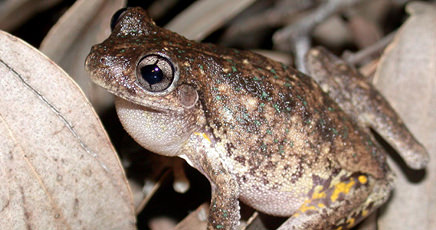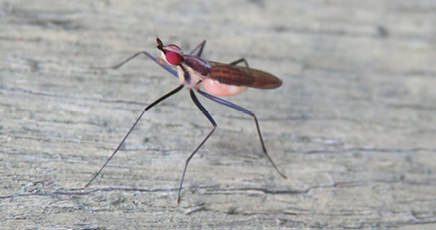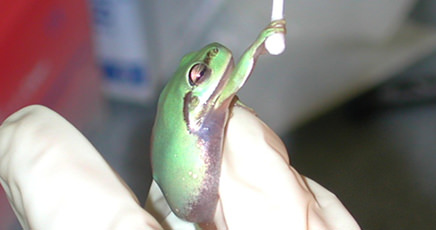STORY
Convinced that there is a colony of frogs living in the local park, Suyin and Tom decided to create a frog-friendly habitat next to the creek. It was important that local community become aware of their existence and why they are important so that more people will actively protect and care for them. Suyin and Tom had lots of support from their school community and the local Landcare group to help rehabilitative the park. The adults helped them submit a formal proposal to the local council for the construction of a frog habitat.

The lack of suitable habitat is a real threat to frogs across Australia. Using thoughtful design processes by understanding the local topography and plants of your local environment will help you take action and create a frog-friendly habitat on your property, at school or at your local community garden. Restoration of habitats increases the land’s ability to support frog populations and helps connect frog communities.
This learning activity is the second part of a sequence of 3 individual learning activities focused on creating a frog-friendly habitat. The order of these learning activities are: research, design and construction.
For children to:
- understand the environment needed to create a frog-friendly habitat
- appreciate and complement the natural settings for a frog-friendly habitat
- learn practical mapping and design skills
- undertake a design task based on research of local frog species.
While this activity can be undertaken any time of year, undertaking this project during times of predictable rainfall are preferable. By observing natural rainfall, you will be able to determine the best location for your frog-friendly habitat. This needs to be considered when designing the habitat.
Introduction
Before constructing a frog-friendly habitat, young learners will be required to create a design or a plan. Learners will apply prior learning and information gathered during the research phase to identify the things to include in their habitat design. Having a sound understanding of the frog’s specific survival needs is essential to designing the frog-friendly habitat. The habitat will be created with both living and non-living elements. The design must be fit for purpose.
*The time allocated is to create a cross section design of the frog-friendly habitat, providing the research phase has been undertaken prior to commencing.
Checklist
Instructions
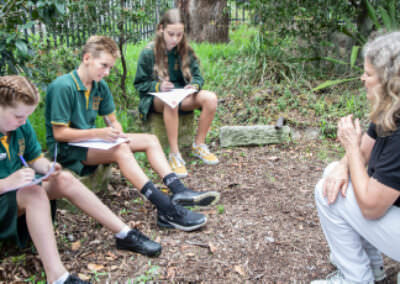
STEP 1
Selecting a site for the frog-friendly habitat.
Choose an area:
- that receives part shade and part sun during the day
- is away from existing large trees; this will avoid falling leaves entering the pond and tree root interference
- away from houses as frogs can be noisy!
- where rainwater naturally pools. Explore the direction that water flows in the schoolyard or yard, preferably after it has rained. The ideal location for the pond may be where runoff naturally accumulates.
Surrounded by vegetation, logs or rocks so the frogs can hide from predators.
Near a compost heap or flower garden if there is one, so there are insects nearby.
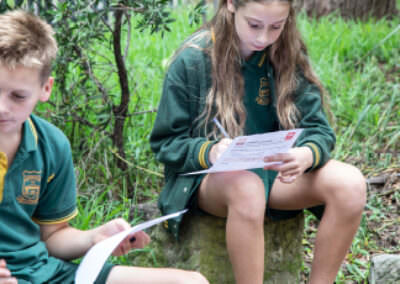
STEP 2
Now that you have selected a suitable location, it’s time to map out the site.
Draw a simple map of your site.
Indicate the position, size and shape of the selected frog habitat site.
Using a measuring tape, measure the area so you know how much space you have for the pond or bog.
Show existing nearby structures, houses, seats, compost bins.
Map existing vegetation, logs or rocks and indicate where water pools naturally after rain, if you have that information.
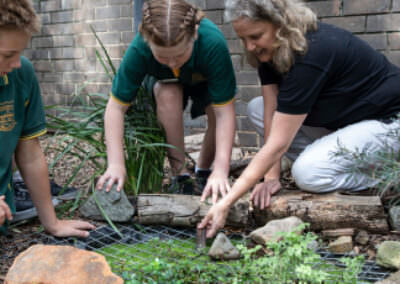
STEP 3
Considerations when designing a frog-friendly habitat:
- design a shallow pond with sloping sides so the frogs can easily enter and exit the pond
- if using a container, include a ramp in the design using logs, rocks, sand or gravel to lessen the gradient so the frogs can climb in and out easily
- decide whether to have an ‘overflow’ pond area for excess rainwater. The overflow pond is built below the height of the main pond and allows for water to move to the smaller pond in case of heavy rain
- select appropriate indigenous aquatic plants for your pond. Some might float while others might grow tall out of the water
- if your site is lacking native vegetation you will need to plant grasses, plants, ground cover and/or shrubs of different heights around the pond to provide hiding spots from predators and shelter from wind. Plants will also attract insects to your pond.
Creating a rock pile or log pile adjacent to the pond will provide shelter and shade.

STEP 4
Draw a labelled cross section of your frog-friendly habitat design (refer to activity sheet).
Include in your design:
- the name of the frog species the habitat is being designed for
- label the building materials required, e.g. UV resistant plastic liner, prefabricated pond, bathtub
- label the selected indigenous plants you will use in and/or out of the water and where they will be placed
- include the approximate dimensions of the frog habitat
- identify the different zones in the habitat: damp, shallow water, deep water.
Extension Activity
Create a prototype of the frog habitat design using modelling clay, sand, thick plastic, water and materials to create artificial plants, grasses and shrubs. This will provide a 3D model as a point of reference and a wonderful visual for the learners.
Refer to your local frog and habitat experts to help you understand more about the habitat and frogs in your local area. Contact your local Landcare group by searching the National Landcare Directory to help find experts who are skilled in designing natural habitats and can share valuable knowledge, such as working closely with councils.
Curriculum and Framework Links
SCIENCE
Year 2: ACSSU031, ACSHE035
Year 3: ACSSU044, ACSHE051
Year 4: ACSHE062, ACSSU073, ACSSU075
Year 5: ACSSU043, ACSHE083
Year 6: ACSSU094, ACSHE100
Year 7: ACSSU112, ACSHE120
Year 8: ACSHE135
Year 9: ACSSU176
GEOGRAPHY
Year 9: ACHGK061
DESIGN & TECHNOLOGIES
Foundation to Year 2: ACTDEP005, ACTDEP006, ACTDEP009
Years 3 & 4: ACTDEK012, ACTDEP015, ACTDEP017
Years 5 & 6: ACTDEK021, ACTDEK023, ACTDEP025, ACTDEP026
Years 7 & 8: ACTDEP036, ACTDEP039
Years 9 & 10: ACTDEP049
CRITICAL AND CREATIVE THINKING:
Generating ideas, possibilities and actions
PERSONAL AND SOCIAL CAPABILITY:
Social awareness
CROSS CURRICULUM PRIORITY
Aboriginal and Torres Straight Islanders Histories and Cultures
Sustainability
My Time, Our Place: Framework for School Age Care
Outcome 2 and 4
Reference List
ONLINE RESOURCES
Be inspired with this story from Rowville Primary School who used a Junior Landcare Grant to build a Frog Bog within their school grounds.
This Frog ID habitat poster from the Australian Museum provides great information on how to create your own frog habitat.
Learn some essential design steps for a building a frog pond from Backyard Buddies.
Frog pond design ideas with some Frog Bog basics from Sustainable Gardening Australia.
WATCH
In this (10 minute) Gardening Australia video look at the construction of a frog bog habitat in an early childhood centre.
Frog Pond Fix-Up (6 minutes) this follow up video looks at some of the mistakes from the building the frog bog and revitalising it with special plants, and features.
IMAGE ATTRIBUTION
Feature image:
Northern Dwarf Tree Frog, Cairns, Australia. Photo by David Clode on Unsplash
Other images:
Perons Tree Frog Litoria peronii from Australian Museum – FrogID
Testing frogs for Chytris Fungus infection. Photographer: Veronica Olsen, CSIRO Livestock Industries.
Image of frog skin. Photographer: Livestock Industries
Ornate Burrowing Frog Platyplectrum ornatum from Australian Museum – FrogID
Images of Australian frogs/insects from What’s in your Backyard challenge.
Just for Kids
Check out our fun activity Frog pond collage
We value your feedback
When you have finished this learning activity, please tell us what you think with our survey.
Your feedback will help Landcare Australia improve the activities in the Junior Landcare Learning Centre.
Why not try one of our other Junior Landcare learning activities?
Creating a butterfly garden
Biodiversity
Love Letters to the Land
Biodiversity|First Nations Perspectives|Food Production|Waste Management
Creating a sensory garden
Biodiversity
Understanding weeds: life cycle
Biodiversity
